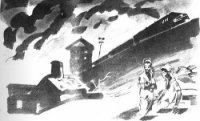Operation Nemesis: The Assassination Plot that Avenged the Armenian Genocide - Bogosian Eric (мир книг .txt) 📗
Though many young men, Turkish and Armenian, did serve in the Turkish army, many others avoided military service at any cost. In the countryside, men hid in the mountains where the gendarmes could not find them. In Constantinople, a vast underground network was created to help them elude the authorities. Young men were hidden in cellars, behind walls, in secret rooms. Throughout the city, this “Army of the Attics” (tavan taburu) numbered in the thousands. Concealing these young men and maintaining the underground support system became an important function of the urban Armenian revolutionaries.
The Central Committee of the CUP quickly came to believe that the Armenian population represented a mortal threat to the dying Ottoman Empire. Enmeshed in war with Britain and Russia and harassed by small bands of Armenian fedayeen on its eastern front, the Ottoman government decided to solve the “Armenian question” once and for all by eliminating all Armenians residing in Anatolia. This eradication of over a million people would proceed in stages, often disguised as deportations. All would be camouflaged by the fog of war.
Examples of ethnic cleansing can be found at least as far back as biblical times, but the slaughter that was to befall the Armenian people in the Ottoman Empire in 1915 was unprecedented in scope and definition. The intensity of the violence, and the staggering numbers of people murdered in such a short period of time—almost one million people—introduced to the world a new phenomenon: genocide, the attempt to eradicate a people, physically and culturally. Equally important, this mass killing was committed by a government against its own subjects. This was not a case of an invading army or a violent colonization of a faraway land. The Armenians were not a rebellious or combative indigenous people settled in conquered territory. Despite the small bands of Armenian guerrillas harassing Ottoman troops during the war, the overwhelming majority of Armenians had steered well clear of politics or rebellion. Rather, they were for the most part peaceful subjects of the sultan who had always lived productively within the borders of the state. The Armenians of the Ottoman Empire paid taxes, obeyed the law, and contributed to the culture and institutions of the empire. Their destruction was a sinister innovation of a society that thought of itself as “modern” and “civilized,” and would foreshadow the systematic mass murder of innocents by Nazi and communist governments only a few decades later.
This was not the first time that the Christians in the eastern provinces of the Ottoman Empire had been attacked directly. Twenty years earlier, intensely violent episodes had wiped out over a hundred thousand Armenians under the watch of Sultan Abdul Hamid II. Tens of thousands more had died in the bloodbaths of 1909 after the Young Turks took power. Bloodletting aimed at the Armenians had become commonplace in the eastern Ottoman vilayets, fostering a “culture of massacre.” With the advent of World War I in 1914, a vastly more efficient and highly organized wave of terror swelled and broke upon an unsuspecting Christian population, removing the Armenians from their ancestral lands altogether.
The operation to remove and ultimately erase the Armenian population in Anatolia went into effect just as World War I was beginning. It was neither random nor unplanned, but rather systematic and centrally orchestrated by a guiding hand in Constantinople. By the end of the summer of 1915, owing to this program of relocation and massacre, most of the hundreds of thousands of Armenians who had been living in Anatolia no longer resided in their villages. By the end of the war, most of those Armenians of the Ottoman Empire who had not managed to cross the border were either dead or dying in the Syrian desert.
The process began in the regions farthest from Constantinople and closest to Russia, and then, with gruesome efficiency, worked its way westward across Asia Minor. Some Armenians in the western vilayets were forced to pay their own way as they were deported by railway, even if this meant traveling in cattle cars. The sick and dying were mixed in with the healthy. The dead were removed at each station and in some instances thrown down the embankments. Along the Black Sea littoral, victims were taken out in boats and drowned. If local Muslim leaders balked at the deportations because they understood that it was nothing more than thinly disguised mass murder, those leaders were replaced. Sometimes they, too, were executed.
Victims were often forced to undress before being killed, since it was against Sharia law to strip clothing off a corpse and then sell it in the market. Many deportees would arrive at their destination completely naked. In addition to being subjected to organized theft, those in the deportation caravans were attacked continually, and whatever meager possessions they had managed to carry were taken. At one point, in a conversation with Ambassador Morgenthau, Talat Pasha demanded the life insurance proceeds for Armenians the regime had murdered! This real property and treasure would contribute to a program of Turkification, thus subsidizing the cost of the deportations themselves.4
The Ottoman campaign against the Armenians of Asia Minor proceeded in the following way:
1) Since the Balkan wars, able-bodied Armenian men faced conscription by the army. Now they were disarmed, segregated from the regular army, and re-formed into “labor battalions” (inshaat taburu). These underfed and ill-clothed young men were worked to death or executed in remote areas.
2) Small villages were surrounded by soldiers or irregulars (chetes) and destroyed. All residents were killed on the spot. The village often would be burned to the ground.
In larger villages or towns where the populace was both Christian and Muslim:
3) Male leaders of the Armenian community were arrested, imprisoned, and tortured. Within a few days, they would be “moved” from the prison to another location, farther from the town. These men would not be seen again, having been executed. This group would include those not eligible for the army but who had some capacity as potential leaders: businessmen, merchants, pharmacists, teachers, clergy.
4) Once the leading men of the community had been removed, a proclamation would announce that the remaining Armenians were being moved to another location. A typical posting, quoted in one survivor account, reads:
Leave all your belongings—your furniture, your beddings, your artifacts. Close your shops and businesses with everything inside. Your doors will be sealed with special stamps. On your return, you will get everything you left behind. Do not sell property or any expensive item. Buyers and sellers alike will be liable for legal action. Put your money in a bank in the name of a relative who is out of the country. Make a list of everything you own, including livestock, and give it to the specified official so that all your things can be returned to you later. You have ten days to comply with this ultimatum.5
Armenians would be given a few days to get their possessions together. Often a “fire sale” would follow, and families would be forced to sell what they couldn’t carry at an extreme discount.6 Large storable possessions—for example, goods in a warehouse or household furniture and carpets—would be confiscated “for safekeeping” by the government. Deportees were forced to sign over real estate deeds. Bank accounts of those who had been deported were taken. Merchants and farmers and tradesmen lost their stock, including foodstuffs, animals, manufactured goods for sale, and raw materials. Small factories, farms, and mines were seized. Churches and church property were confiscated and converted into mosques.7




